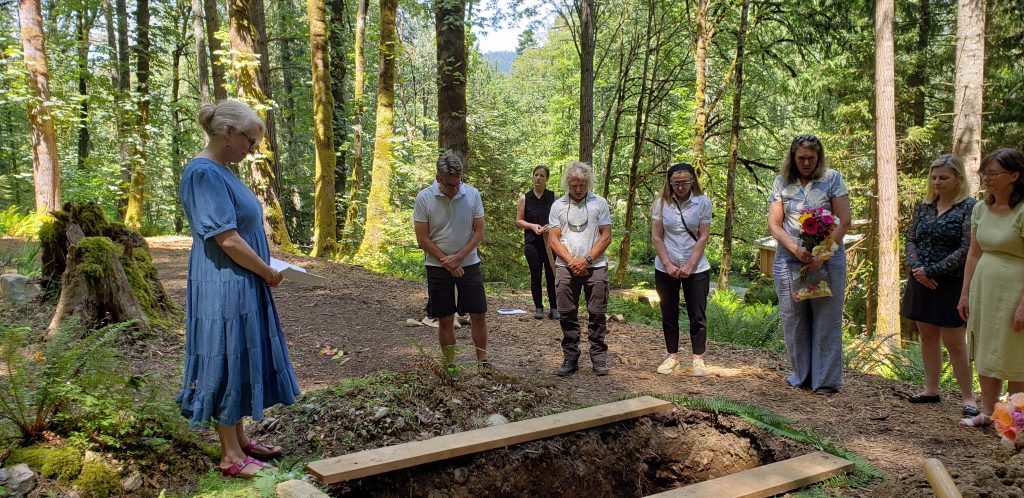Green Burials

We are grateful to Nicola Finch for her enlightening article on green burials.
Photo credited to ‘Cathy Valentine, Salt Spring island Natural Cemetery’
It is not going to be everyone’s choice, nor should it be. What happens to our bodies once we’re dead is personal.
Conventional burial and flame cremation have been the disposition of choice in BC for just a few generations. With almost 90% of our population currently choosing flame cremation, it’s important to note that it’s not the greenest alternative to conventional burial. It is however, still the most affordable option and it gives families the opportunity to memorialize their people (and their pets) in myriad ways and in their own time. Conventional burial with hardwood caskets, concrete or fibreglass grave liners, and embalmed bodies is becoming less common as the cost of a burial plot is out of reach for many and as we grow ever more concerned about our individual and collective environmental impact on the planet.
What was old becomes new again, and green burial is making a comeback. Dig a grave where the land needs nourishment. Lay down a bed of moss and wildflowers. Bury our beloved dead. Naturally.
The five guiding principals of Green Burial are: No Embalming, Direct Earth Burial, Ecological Restoration and Conservation, Simple Memorialization, and Optimized Land Use. Providing Green Burial options throughout BC could ease the burden of having to build more and more facilities to ‘dispose’ of our dead no matter how environmentally friendly those disposition methods might be. Facilities, equipment, power, fuel, water, maintenance; so little is required if we simply return to the basics.
We are fortunate in British Columbia to have, at last count, 17 cemeteries where green burial is an option. Small rural communities in BC may also offer natural burial, quietly, to local residents without the requirement of vaults or grave liners. Most First Nations communities can provide what we call a green burial because their cemeteries are self-governed.
Some but not all of BC’s green cemeteries have sought certification. The Green Burial Society in Canada and the US Green Burial Council are the recognized certification bodies in North America for green burial cemeteries. There is a wealth of resources on both websites for anyone seeking reliable and in-depth information. In British Columbia, there is also Green Burial BC where you will find information specific to natural burial in British Columbia including a map and listings of where Green Burial is available in the province. Listed on the Speaker’s Bureau are individuals from around the province who can be requested to speak to your group or organization on Green Burial.
There is of course, so much more to Green Burial than how our bodies meet the earth. There are rich opportunities for meaningful ceremony, family and community involvement, having a beautiful place in nature to say goodbye, and having that place to return to in remembrance. There is the important aspect of conserving and protecting threatened ecosystems. Green Burial cemeteries and hybrid cemeteries usually offer interment or scattering of cremated remains as well. Some cemeteries and green burial grounds are including innovative ways of making ashes more earth friendly and of providing environmentally friendly ways of memorializing our beloved dead.
If a green burial is unavailable in or near your community, we can still seek to lessen the environmental impact of our death and disposition. Choosing a biodegradable casket, choosing more natural body preparation (that doesn’t include embalming), requesting burial without a vault or liner, using local garden flowers at ceremonies; even carpooling can lessen our impact.
No matter what we prefer as a final disposition, it’s important to make those decisions, talk with family, and record our wishes.
Resources:
The Green Burial Society – Canada
The Green Burial Council – USA
Green Burial BC – British Columbia
Nicola Finch is a Natural Burial and Community Deathcare advocate. She lives remote and off-grid in the Cariboo and is a photographer, writer and small business owner.
